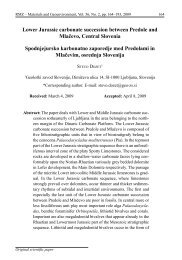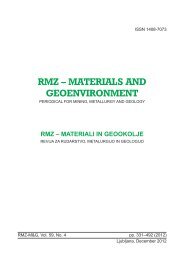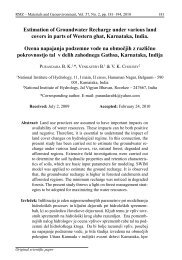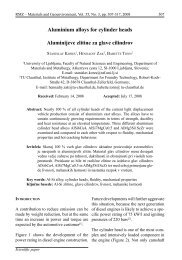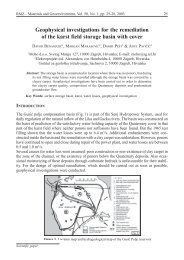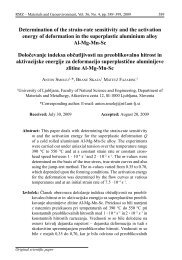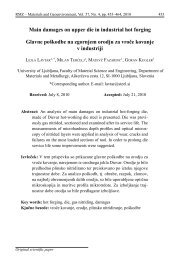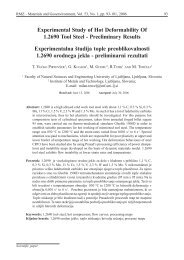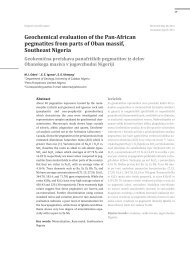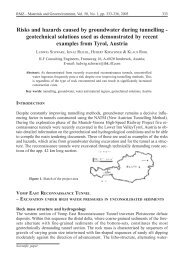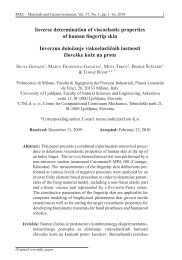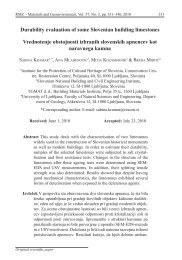Petrochemistry and genetic indicators of talcose rock of Esie ... - RMZ
Petrochemistry and genetic indicators of talcose rock of Esie ... - RMZ
Petrochemistry and genetic indicators of talcose rock of Esie ... - RMZ
Create successful ePaper yourself
Turn your PDF publications into a flip-book with our unique Google optimized e-Paper software.
<strong>RMZ</strong> – Materials <strong>and</strong> Geoenvironment, Vol. 57, No. 3, pp. 363–386, 2010<br />
363<br />
<strong>Petrochemistry</strong> <strong>and</strong> <strong>genetic</strong> <strong>indicators</strong> <strong>of</strong> <strong>talcose</strong> <strong>rock</strong><br />
<strong>of</strong> <strong>Esie</strong> area, southwestern Nigeria<br />
Petrokemija in pokazatelji geneze lojevčevih kamnin<br />
(skrilavcev) območja <strong>Esie</strong>, jugozahodna Nigerija<br />
Olorunfemi, A. O. 1 , Olarewaju, V. O. 1 & Okunlola, O. A. 2,*<br />
1<br />
Department <strong>of</strong> Geology, Obafemi Awolowo University, Ile-Ife, Nigeria<br />
2<br />
Department <strong>of</strong> Geology, University <strong>of</strong> Ibadan, Ibadan, Nigeria<br />
*Corresponding author. E-mail: gbengaokunlola@yahoo.co.uk<br />
Received: October 25, 2009 Accepted: February 11, 2010<br />
Abstract: Field, petrographic <strong>and</strong> geochemical data have been employed<br />
in appraising the compositional <strong>and</strong> the petro<strong>genetic</strong><br />
nature <strong>of</strong> the talc schist <strong>of</strong> <strong>Esie</strong> <strong>and</strong> environs, southwestern<br />
Nigeria. The <strong>rock</strong> unit occurs as low-lying lensoidal outcrops<br />
<strong>and</strong> in some places as massive or weakly foliated exposures.<br />
The main mineral assemblage <strong>of</strong> the <strong>rock</strong> is talc + anthophyllite<br />
<strong>and</strong> talc + chlorite + anthophyllite. Accessory minerals are<br />
ilmenite, hematite <strong>and</strong> spinel.<br />
The variation plots <strong>of</strong> major oxides MgO, Al 2<br />
O 3<br />
, TiO 2<br />
<strong>and</strong><br />
SiO 2<br />
on one h<strong>and</strong> <strong>and</strong> trace elements Ni, <strong>and</strong> Sc on the other,<br />
confirm komatiitic nature <strong>of</strong> the <strong>rock</strong>. Also, Petro<strong>genetic</strong> inferences<br />
based on the rare earth elements (REE) <strong>and</strong> transition<br />
trace elements abundances, notably Ni <strong>and</strong> Cr, reveal almost<br />
flat heavy REE <strong>and</strong> enriched light REE (LREE) [(La : Sm) n<br />
=<br />
1.53–5.06 <strong>and</strong> (Ce : Yb) n<br />
= 3.62–124.91] patterns. Ni (637–<br />
1870 µg/g) <strong>and</strong> Cr contents (1330–3440 µg/g) are consistent<br />
with the ultramafic parentage <strong>and</strong> komatiitic character <strong>of</strong> the<br />
<strong>rock</strong>.<br />
A partial melting <strong>of</strong> upper mantle with variable post magmatic<br />
alteration/modification evolutionary model is proposed for the<br />
<strong>rock</strong> unit.<br />
Original scientific paper
364 Olorunfemi, A. O., Olarewaju, V. O. & Okunlola, O. A.<br />
Povzetek: Za oceno sestave in petrogenetskih lastnosti lojevčevih<br />
skrilavcev širšega območja <strong>Esie</strong> v jugovzhodni Nigeriji smo<br />
uporabili podatke terenskih, petrografskih in geokemičnih raziskav.<br />
Litološka enota se pojavlja kot lečasti in ponekod masivni<br />
ali šibko foliirani izdanki. Glavna mineralna parageneza<br />
kamnine so lojevec + ant<strong>of</strong>ilit in lojevec + klorit + ant<strong>of</strong>ilit.<br />
Akcesorni minerali so ilmenit, hematit in spinel. Variacijski<br />
diagrami glavnih oksidov MgO, Al 2<br />
O 3<br />
, TiO 2<br />
in SiO 2<br />
na eni<br />
strani in slednih prvin Ni in Sc na drugi potrjujejo komatiitno<br />
naravo kamnine. Z geokemičnimi raziskavami elementov redkih<br />
zemelj (REE) smo dobili skoraj raven vzorec težkih REE<br />
in obogatene lahke REE (LREE) [(La : Sm) n<br />
= 1.53–5.06 in<br />
(Ce : Yb) n<br />
= 3.62–124.91]. Vsebnosti prehodnih slednih prvin,<br />
predvsem Ni in Cr [Ni (637–1870 µg/g) in Cr (1330–3440<br />
µg/g)], se ujemajo z ultramafičnim poreklom in komatiitnim<br />
značajem kamnine.<br />
Na tej osnovi je predlagan model nastanka litološke enote z<br />
delnim taljenjem zgornjega plašča, ki je bila postmagmatsko<br />
izpostavljena različni stopnji sprememb.<br />
Key words: komatiite, petrogenesis, <strong>talcose</strong> <strong>rock</strong>s, trace elements,<br />
REE, <strong>Esie</strong>, Nigeria<br />
Ključne besede: komatiit, petrogeneza, lojevčeve kamnine (skrilavci),<br />
sledne prvine, REE, <strong>Esie</strong>, Nigerija<br />
Introduction<br />
The Nigerian basement complex (Figure<br />
1) consists <strong>of</strong> Precambrian gneisses<br />
<strong>and</strong> migmatitic <strong>rock</strong>s into which belts <strong>of</strong><br />
N-S trending low to medium grade supracrustal<br />
<strong>rock</strong>s are infolded (Ajibade<br />
et al., 1987). This supracrustal <strong>rock</strong>s,<br />
otherwise called the schists, consist <strong>of</strong><br />
low to medium-grade metasediments<br />
<strong>of</strong> pelitic to semi-pelitic compositions,<br />
belonging to carbonates, psammitic<br />
<strong>rock</strong>s as well as mafic <strong>and</strong> ultramafic<br />
(<strong>talcose</strong>) <strong>rock</strong>s.These occur as lenticular<br />
to ovoid shaped bodies intercalated<br />
within the metasediments. Both basement<br />
<strong>and</strong> supracrustal cover sequence<br />
have suffered polyphase deformation<br />
<strong>and</strong> metamorphism <strong>and</strong> are Intruded in<br />
some places by Pan-African granitoids.<br />
The schist belts include those <strong>of</strong> Ilesha,<br />
Kusheriki, Maru, Wonaka <strong>and</strong><br />
Anka. (Olade & Elueze, 1979; Ajayi,<br />
<strong>RMZ</strong>-M&G 2010, 57
<strong>Petrochemistry</strong> <strong>and</strong> <strong>genetic</strong> <strong>indicators</strong> <strong>of</strong> <strong>talcose</strong> <strong>rock</strong> <strong>of</strong> <strong>Esie</strong> area, southwestern Nigeria<br />
365<br />
1981; Kayode, 1981; Elueze, 1982;<br />
Klemm et al, 1984; Ige & Asubiojo,<br />
1991;Truswell & Cope, 1963; Elueze,<br />
1982; Ogezi, 1977) (Figure 1). Previous<br />
researchers attributed pre-metamorphic<br />
parent <strong>rock</strong>s to peridotite (Elueze,<br />
1982), to magmatic origin (Ige &<br />
Asubiojo, 1991) or to tectonically emplaced<br />
slices <strong>of</strong> upper mantle material<br />
(Ogezi, 1977). The <strong>rock</strong>s in these areas<br />
are hardly preserved in their original<br />
state. Many bodies have suffered varying<br />
degrees <strong>of</strong> alteration <strong>and</strong> are extensively<br />
steatitized. Meta-utramafites<br />
are minor components <strong>of</strong> the Nigerian<br />
schist belts.<br />
The <strong>Esie</strong> schistose <strong>rock</strong>s have been<br />
considered by some workers in the<br />
past to lie within the Egbe-Isanlu schist<br />
belt exposed in southwestern Nigeria<br />
(Annor, 1981, Ige & Onabajo, 2005).<br />
However, the <strong>Esie</strong> <strong>talcose</strong> <strong>rock</strong> actually<br />
is a northern extension <strong>of</strong> Ife-Ilesha<br />
schist belt. It lies within latitudes<br />
<strong>of</strong> 4 0 45’–5 0 00’ North <strong>and</strong> longitudes<br />
8 0 00’–8 0 15’ East (Figure 1). The previous<br />
studies on the Ife Ilesha schistose<br />
<strong>rock</strong>s have generally focused on<br />
tectonic modeling (Rahaman, 1976;<br />
Olade & Elueze, 1979; Ajayi, 1981)<br />
<strong>and</strong> stratigraphic correlation (Klemm<br />
et al, 1983) with interpretations being<br />
based on major <strong>and</strong> trace element data.<br />
The <strong>Esie</strong> <strong>talcose</strong> <strong>rock</strong> have been studied<br />
mainly for their economic potential<br />
(Olorunfemi, 2007; Olorunfemi et<br />
al., 2009) <strong>and</strong> archaeological features<br />
(Olabanji et al., 1989; Ige & Onabajo,<br />
2005).<br />
The present study therefore, focuses<br />
on elucidating the origin <strong>and</strong> petrochemical<br />
characteristics <strong>of</strong> the <strong>talcose</strong><br />
<strong>rock</strong> <strong>of</strong> <strong>Esie</strong> area in the northern part<br />
<strong>of</strong> Ife-Ilesha schist belt, <strong>and</strong> is expected<br />
to contribute to the knowledge <strong>of</strong> the<br />
geodynamic evolution <strong>of</strong> the schist belt<br />
in Nigeria.<br />
Materials <strong>and</strong> Methods<br />
For this purpose a systematic geological<br />
mapping was undertaken on a scale<br />
<strong>of</strong> 1 : 25,000. Optical (thin section)<br />
<strong>and</strong> X Ray Diffraction studies were<br />
carried out in order to underst<strong>and</strong> the<br />
mineralogical composition. For the<br />
XRD determinations, powders <strong>of</strong> representative<br />
samples <strong>of</strong> six <strong>of</strong> the talc<br />
bodies were examined using a Philips–<br />
PW1011 model diffractometer. The<br />
diffractograms were recorded using a<br />
scanning rate 2 o min –1 cm –1 with a Nifiltered<br />
Fe K-alpha radiation.<br />
Twelve pulverized samples <strong>of</strong> the <strong>rock</strong><br />
unit were also chemically analyzed<br />
for major, trace <strong>and</strong> rare earth element<br />
composition by inductively coupled<br />
plasma–mass spectrometry (ICP-MS)<br />
instrumentation method at the Activation<br />
Laboratory Ontario, Canada. The<br />
detailed analytical procedure is described<br />
in Olorunfemi (2007).<br />
<strong>RMZ</strong>-M&G 2010, 57
366 Olorunfemi, A. O., Olarewaju, V. O. & Okunlola, O. A.<br />
Geological Setting <strong>and</strong> Petrography<br />
The study area belongs to the Nigerian<br />
Basement Complex, which forms part<br />
<strong>of</strong> the mobile belt (Figure 1) that lies<br />
between the Archean to Early Proterozoic<br />
West African <strong>and</strong> Congo Cratons<br />
(Kennedy, 1964). The dominant N-S<br />
trending structures <strong>and</strong> extensive areas<br />
<strong>of</strong> igneous rejuvenation <strong>of</strong> this basement<br />
are attributed to the Pan African<br />
Orogenic events (McCurry 1976, Van<br />
Breeman et.al 1977).<br />
In <strong>Esie</strong>, this unit occurs as low-lying<br />
boulders, massive or weakly foliated outcrops<br />
<strong>and</strong> also as lensoid bodies within<br />
country <strong>rock</strong>s (Figure 2). The low lying<br />
nature <strong>of</strong> the outcrops imposes a kind <strong>of</strong><br />
flat to gently undulating terrain in some<br />
areas. Most outcrops <strong>of</strong> the talc deposits<br />
body are located around the southwestern<br />
end <strong>of</strong> the area. The boulder like <strong>and</strong><br />
the massive varieties are whitish to grey<br />
in colour. However, some masses are<br />
brownish in colour probably due to iron<br />
Figure 1. Map <strong>of</strong> Nigeria showing the location <strong>of</strong> <strong>Esie</strong> in the northern part<br />
<strong>of</strong> Ife-Ilesa schist belt. Inset: Map showing the location <strong>of</strong> the Nigerian<br />
basement within the Pan-African<br />
<strong>RMZ</strong>-M&G 2010, 57
<strong>Petrochemistry</strong> <strong>and</strong> <strong>genetic</strong> <strong>indicators</strong> <strong>of</strong> <strong>talcose</strong> <strong>rock</strong> <strong>of</strong> <strong>Esie</strong> area, southwestern Nigeria<br />
367<br />
percolation <strong>and</strong> pigmentation. Most <strong>of</strong><br />
the samples are medium to fine-grained<br />
in texture with a characteristic soapy<br />
touch. The total extent along a NNE-<br />
SSW strike is about 10 km although the<br />
outcrops are not continuous.<br />
Figure 2. (Modified geological map from Geological Survey <strong>of</strong> Nigeria,<br />
2004 <strong>and</strong> Olorunfemi, 2007)<br />
<strong>RMZ</strong>-M&G 2010, 57
368 Olorunfemi, A. O., Olarewaju, V. O. & Okunlola, O. A.<br />
The <strong>Esie</strong> <strong>talcose</strong> <strong>rock</strong> consists <strong>of</strong> talc<br />
as the most common mineral. This occurs<br />
together with varying amounts <strong>of</strong><br />
chlorite, anthophyllite, <strong>and</strong> or tremolite.<br />
Primary silicate minerals are not<br />
preserved in this assemblage. The results<br />
<strong>of</strong> the X-ray diffraction analysis<br />
<strong>of</strong> powdered samples <strong>of</strong> the <strong>rock</strong><br />
show conspicuous peaks <strong>of</strong> talc, anthophyllite<br />
<strong>and</strong> chlorite. Other minor<br />
peaks include mainly those <strong>of</strong> spinel,<br />
(Figures 3 <strong>and</strong> 4). Two petrographic<br />
varieties <strong>of</strong> this <strong>rock</strong> unit were distinguished<br />
being different in colour: talcanthophyllite-schist<br />
<strong>and</strong> talc-chloriteanthophyllite-schist.<br />
Figure 3. X-ray diffraction chart <strong>of</strong> <strong>talcose</strong> <strong>rock</strong> sample<br />
Figure 4. X-ray diffraction chart <strong>of</strong> the <strong>talcose</strong> <strong>rock</strong> sample with chlorite<br />
<strong>and</strong> anthophyllite<br />
<strong>RMZ</strong>-M&G 2010, 57
<strong>Petrochemistry</strong> <strong>and</strong> <strong>genetic</strong> <strong>indicators</strong> <strong>of</strong> <strong>talcose</strong> <strong>rock</strong> <strong>of</strong> <strong>Esie</strong> area, southwestern Nigeria<br />
369<br />
Figure 5a. Photomicrograph <strong>of</strong> <strong>Esie</strong> <strong>talcose</strong><br />
<strong>rock</strong>s showing alteration <strong>of</strong> anthophyllite<br />
(an) within talc (t) matrix (x100).<br />
XPL= crossed polarized light<br />
Figure 5b. Photomicrograph <strong>of</strong> <strong>Esie</strong> <strong>talcose</strong><br />
<strong>rock</strong>s showing chlorite (chl) filling<br />
the interstices <strong>of</strong> the platy talc (t) (×100).<br />
XPL= crossed polarized light.<br />
Figure 5c. Photomicrograph <strong>of</strong> <strong>Esie</strong> <strong>talcose</strong><br />
<strong>rock</strong>s showing decussate arrangement<br />
<strong>of</strong> short <strong>and</strong> a long prismatic anthophyllite<br />
(an) within talc (t) matrix (×100). XPL=<br />
crossed polarized ligh<br />
Talc-anthophyllite-schist consists <strong>of</strong> a<br />
large foliated mass <strong>of</strong> fine platy to fibrous<br />
aggregate <strong>of</strong> talc <strong>and</strong> traces <strong>of</strong><br />
altered anthophyllite (Figure 5a). The<br />
<strong>rock</strong> varies in colour from buff white<br />
to light greyish green. Talc-chlorite-anthophyllite-schist<br />
consists <strong>of</strong> fine platy<br />
or fibrous aggregates <strong>of</strong> talc as well.<br />
Besides, radiating crystals <strong>of</strong> chlorites<br />
cluster in the talc matrix (Figure 5b),<br />
while anthophyllite forms long <strong>and</strong><br />
short prismatic crystals. Some <strong>of</strong> them<br />
exhibit decussate arrangement <strong>and</strong><br />
show spinifex texture (Figure 5c). The<br />
<strong>rock</strong> colour varies from buff-white to<br />
green depending on the relative proportion<br />
<strong>of</strong> the constituent minerals. When<br />
anthophyllite is dominant, the <strong>rock</strong> has<br />
a buff-white colour <strong>and</strong> a greenish one<br />
when chlorite prevails. Talc has been<br />
assessed to be between 70 % <strong>and</strong> 80 %<br />
(Figures, 3, 4, <strong>and</strong> 5). The proportion<br />
<strong>of</strong> anthophyllite <strong>and</strong> chlorite vary considerably<br />
while tremolite <strong>and</strong> opaque<br />
occurs in trace amounts.<br />
For figs 5a-c, lower edge <strong>of</strong> the photo<br />
is 2mm<br />
Talc in thin sections occurs as foliated<br />
mass, coarse to fine platy or fibrous<br />
<strong>RMZ</strong>-M&G 2010, 57
370 Olorunfemi, A. O., Olarewaju, V. O. & Okunlola, O. A.<br />
aggregates with parallel arrangement<br />
(Figure 5a). Anthophyllite is found as<br />
long or short prismatic crystals <strong>and</strong><br />
exhibits a parallel extinction. It forms<br />
a radiating texture with decussate like<br />
arrangement radiating within the matrix<br />
<strong>of</strong> talc (Figure 5). Alteration <strong>of</strong><br />
anthophyllite to talc is visible in some<br />
samples (Figure 5a). Chlorite is seen<br />
as net-like crystals within talc matrix<br />
(Figure 5b). It is greenish in colour<br />
<strong>and</strong> is strongly pleochroic in shades <strong>of</strong><br />
green <strong>and</strong> brown.<br />
Geochemical results <strong>and</strong> discussion<br />
Tables 1a, 1b <strong>and</strong> 1c show the results<br />
<strong>of</strong> major, trace <strong>and</strong> rare earth element<br />
compositions <strong>of</strong> the <strong>Esie</strong> <strong>talcose</strong> <strong>rock</strong>s.<br />
All the samples from <strong>Esie</strong> show high<br />
MgO with mass fractions w/% (26.09–<br />
31.35 %) <strong>and</strong> low Al 2<br />
O 3<br />
(0.50–5.54 %),<br />
K 2<br />
O (0.01–0.12 %), P 2<br />
O 5<br />
(0.01–0.03 %),<br />
MnO (0.03–0.178 %) <strong>and</strong> TiO 2<br />
(0.008–<br />
0.126 %) (Table 1a). The SiO 2<br />
content <strong>of</strong><br />
all the samples is generally in excess <strong>of</strong><br />
50 %. Values <strong>of</strong> SiO 2<br />
greater than 45 %<br />
are generally regarded as upper limit for<br />
ultramafic igneous <strong>rock</strong>s. Considering the<br />
above, <strong>and</strong> in comparison with <strong>rock</strong>s <strong>of</strong><br />
similar compositional characteristics, the<br />
overall major element chemical composition<br />
<strong>of</strong> the <strong>rock</strong>s is distinctly similar to<br />
<strong>rock</strong>s <strong>of</strong> komatiitic series <strong>and</strong> peridotitic<br />
affinity (Brooks & Hart, 1974; Arndt et<br />
al., 1977; Elueze, 1982). However, the<br />
seemingly high SiO 2<br />
content may suggest<br />
possible syntectonic metamorphic silicification<br />
<strong>of</strong> the <strong>rock</strong>.<br />
The concentrations <strong>of</strong> the transitional<br />
trace elements Ni (637–1870 µg/g) <strong>and</strong><br />
Cr (1330–3440 µg/g) in the <strong>rock</strong> samples<br />
are also similar to those <strong>of</strong> peridotites<br />
(Divakara Rao et al., 1975). This feature<br />
indicates a parental magma derived from<br />
a mantle peridotite source (Rollinson,<br />
1993). High Ni, Cr <strong>and</strong> MgO content in<br />
the samples coupled with a seemingly<br />
positive relationship (Table 1a, b). Suggests<br />
original magmatic partitioning <strong>and</strong><br />
points to the existence <strong>of</strong> a high Ni-phase,<br />
presumably olivine in the parent <strong>rock</strong>s<br />
(Hawkesworth & O’nion 1977). Co <strong>and</strong><br />
Ni are <strong>of</strong>ten thought to have similar geochemical<br />
behavior, although the distribution<br />
coefficient <strong>of</strong> Co in olivine/liquid is<br />
in general lower than <strong>of</strong> Ni (Duke, 1976;<br />
Leeman, 1974). By the same argument, the<br />
high Cr-phase may be spinel or Cr-rich orthopyroxene.<br />
Arndt (1976) has shown that<br />
the liquidus phases in a melt with MgO ><br />
20 % are olivine <strong>and</strong> chromite; if MgO is<br />
between 2.0 % to 12 %, olivine + pyroxene;<br />
<strong>and</strong> with MgO < 12 %, pyroxene +<br />
plagioclase.<br />
The <strong>talcose</strong> <strong>rock</strong> samples have variable<br />
contents <strong>of</strong> V, Cu <strong>and</strong> Zn. The low V <strong>and</strong><br />
Cu contents compared to all other elements<br />
possibly reflects the primitive nature<br />
<strong>of</strong> these <strong>rock</strong>s. The Cu <strong>and</strong> Zn contents<br />
are highly variable in the samples<br />
with the sample being generally poorer<br />
in Cu but elevated values <strong>of</strong> Zn (Table<br />
1b). This behavior may be as a result <strong>of</strong><br />
the high mobility <strong>of</strong> Zn during weathering<br />
processes. The Rb <strong>and</strong> Hf contents <strong>of</strong><br />
<strong>RMZ</strong>-M&G 2010, 57
<strong>Petrochemistry</strong> <strong>and</strong> <strong>genetic</strong> <strong>indicators</strong> <strong>of</strong> <strong>talcose</strong> <strong>rock</strong> <strong>of</strong> <strong>Esie</strong> area, southwestern Nigeria<br />
371<br />
Table 1a. Major elements data (w/%) <strong>of</strong> <strong>Esie</strong> <strong>talcose</strong> <strong>rock</strong>s <strong>and</strong> data from typical examples<br />
<strong>of</strong> ultramafic <strong>rock</strong>s <strong>of</strong> komatiitic affinity (w/%)<br />
Oxides 1 2 3 4 5 6 7 8 9 10 11 12<br />
Mean<br />
13<br />
S834 Gt<br />
SiO 2<br />
55.41 58.18 57.99 52.87 58.30 57.97 58.19 57.10 50.48 55.32 55.38 57.38 56.21 43.61 50.16<br />
Al 2<br />
O 3<br />
2.45 0.64 0.55 2.76 0.95 0.85 0.53 1.12 5.54 1.77 2.11 0.5 1.66 7.71 4.46<br />
Fe 2<br />
O 3<br />
T 6.93 5.74 6.73 7.51 5.23 6.49 5.61 7.6 7.09 7.31 10.63 6.03 6.90 10.45 2.54<br />
MnO 0.072 0.069 0.121 0.178 0.088 0.106 0.072 0.139 0.096 0.134 0.206 0.03 0.10 0.16 0.22<br />
MgO 28.68 30.56 29.81 31.35 30.44 29.76 30.08 29.18 29.91 30.26 26.09 30.47 29.71 25.32 23.86<br />
CaO 0.04 0.01 0.12 0.31 0.04 0.01 0.01 0.03 0.17 0.21 0.37 0.01 0.16 6.86 4.79<br />
Na 2<br />
O 0.17 0.16 0.16 0.16 0.25 0.18 0.15 0.15 0.12 0.18 0.20 0.09 0.16 0.20 0.3<br />
K 2<br />
O 0.03 0.01 0.01 0.04 0.01 0.01 0.01 0.01 0.05 0.07 0.12 0.01 0.03 0.10 0.01<br />
TiO 2<br />
0.053 0.017 0.008 0.073 0.034 0.028 0.008 0.038 0.126 0.044 0.061 0.056 0.05 0.33 0.45<br />
P 2<br />
O 5<br />
0.02 0.01 0.03 0.03 0.01 0.03 0.01 0.02 0.01 0.01 0.01 0.01 0.02 0.06 0.1<br />
LOI 5.16 4.6 3.9 4.23 4.49 4.24 4.68 4.67 6.07 4.22 4.57 4.76 4.63 6.15 2.03<br />
Total 99.01 99.96 99.59 99.73 99.79 99.75 99.36 99.78 99.65 99.53 99.75 99.91 99.65 100.41 99.97<br />
CaO/Al 2<br />
O 3<br />
0.02 0.02 0.21 0.11 0.04 0.01 0.01 0.03 0.03 0.19 0.18 0.02 0.10<br />
**FeO 6.23 5.16 6.05 6.75 4.70 5.84 5.04 6.83 6.38 6.57 9.56 5.42<br />
- = not detected<br />
1–12 = Samples from <strong>Esie</strong> (talc-anthophyllite-chlorite) (This Study)<br />
13 = Mean values <strong>of</strong> samples 1–12<br />
S834 = Komatiite from Suomussalmi, Finl<strong>and</strong> (Jahn et.al., 1980)<br />
Gt = Ife meta-ultramafite: anthophyllite- talc/tremolite-chlorite (trace) - magnetite-(trace). Ige &<br />
Asubiojo, 1991.<br />
** FeO = Fe 2<br />
O 3<br />
/1.112<br />
Table 1b. Trace elements data (µg/g) <strong>of</strong> <strong>Esie</strong> <strong>talcose</strong> <strong>rock</strong> <strong>and</strong> data from typical examples<br />
<strong>of</strong> ultramafic <strong>rock</strong>s <strong>of</strong> komatiitic affinity (µg/g)<br />
Elements 1 2 3 4 5 6 7 8 9 10 11 12 Mean S834 Gt<br />
Sc 6 4 3 7 3 2 3 2 4 4 26 2 5.5 - 10<br />
V 5 9
372 Olorunfemi, A. O., Olarewaju, V. O. & Okunlola, O. A.<br />
Table 1c. Rare earth elements data (µg/g) <strong>of</strong> <strong>Esie</strong> <strong>talcose</strong> <strong>rock</strong>s <strong>and</strong> data from typical<br />
examples <strong>of</strong> ultramafic <strong>rock</strong>s <strong>of</strong> komatiitic affinity (µg/g)<br />
Elements 1 2 3 4 5 6 7 8 9 10 11 12 Mean S834 Gt<br />
La 1.4 0.5 6.5 3.6 1.7 1.6 1.6 1.8 1.4 1.0 2.0 2.5 2.13 0.634 3.0<br />
Ce 4.7 0.7 9.4 17 39.8 48.6 70.3 46.9 30.3 2.8 17.7 3.6 24.31 2.292 7.9<br />
Pr 0.37 0.16 1.48 1.04 0.66 0.48 0.6 0.53 0.34 0.26 0.69 0.86 0.62<br />
Nd 1.4 0.6 5.2 3.6 2.7 1.7 2.2 1.8 1.1 1.0 2.6 3.1 2.25 2.11 1.8<br />
Sm 0.3 0.2 0.8 0.7 0.7 0.3 0.5 0.5 0.2 0.2 0.7 0.6 0.48 0.742 0.7<br />
Eu 0.06
<strong>Petrochemistry</strong> <strong>and</strong> <strong>genetic</strong> <strong>indicators</strong> <strong>of</strong> <strong>talcose</strong> <strong>rock</strong> <strong>of</strong> <strong>Esie</strong> area, southwestern Nigeria<br />
373<br />
Figures 6a, b. Variation <strong>of</strong> TiO 2<br />
with SiO 2<br />
<strong>and</strong> Al 2<br />
O 3<br />
(w/%)<br />
<strong>RMZ</strong>-M&G 2010, 57
374 Olorunfemi, A. O., Olarewaju, V. O. & Okunlola, O. A.<br />
Figure 7a. Variation <strong>of</strong> Al 2<br />
O 3<br />
with w(FeO/(FeO + MgO))/% ratio in <strong>Esie</strong><br />
<strong>talcose</strong> <strong>rock</strong>s (Naldrett & Cabri, 1976). Samples plot in the komatiite field.<br />
PK: Peridotitic komatiite,<br />
BK: Basaltic komatiite,<br />
HFT: High-Fe tholeiite basalt<br />
HMT: High-Mg tholeiite basalt,<br />
HMT: High-Mg tholeiite basalt,<br />
TA: Tholeiitic <strong>and</strong>esite<br />
TD: Tholeiitic dacite,<br />
TR: Tholeiitic rhyolite,<br />
CB: Calc – alkali basalt,<br />
CA: Calc-alkali <strong>and</strong>esite,<br />
CD: Calc-alkali dacite,<br />
CR: Calc-alkali rhyolite<br />
Figure 7b. Classification <strong>of</strong> volcanic <strong>rock</strong>s after Jenson (1976). On the<br />
diagram, <strong>Esie</strong> <strong>talcose</strong> <strong>rock</strong>s plot in the field <strong>of</strong> peridotitic komatiite.<br />
<strong>RMZ</strong>-M&G 2010, 57
<strong>Petrochemistry</strong> <strong>and</strong> <strong>genetic</strong> <strong>indicators</strong> <strong>of</strong> <strong>talcose</strong> <strong>rock</strong> <strong>of</strong> <strong>Esie</strong> area, southwestern Nigeria<br />
375<br />
Due to their coherent geochemical<br />
behaviour, REE are considered as resistant<br />
to post magmatic alterations<br />
<strong>and</strong> metamorphism. Therefore, they<br />
have been used in this study to present<br />
petro<strong>genetic</strong> <strong>and</strong> petrotectonic interpretations.<br />
Although, ambiguity may<br />
sometimes emerge when a detailed<br />
comparison is made between different<br />
<strong>rock</strong> units, yet, they are still fairly good<br />
<strong>indicators</strong> (Jahn & Sun, 1979). Rare<br />
earth elements features as shown in the<br />
chondrite-normalized REE patterns for<br />
these <strong>rock</strong>s (Figure 8a <strong>and</strong> 8b) reveal<br />
that almost all the samples are high in<br />
total REE abundance. The values range<br />
from about 3.00 to 76.41 µg/g with an<br />
average value <strong>of</strong> 31.23 µg/g (Tables<br />
1c, <strong>and</strong> 2).This indicates that this <strong>rock</strong><br />
unit is distinctly different from those <strong>of</strong><br />
ophhiolite from an orogen, but rather<br />
close to those <strong>of</strong> the ultramafic melanocratic<br />
<strong>rock</strong> series.(Wang Yuwang et.<br />
al., 2004) The <strong>talcose</strong> <strong>rock</strong> is enriched<br />
in LREE with (Ce/Sm) n<br />
ranging from<br />
0.83 to 39.07 <strong>and</strong> moderate fractionation<br />
<strong>of</strong> source magma as shown by (La/<br />
Yb) n<br />
ratios (3.37–21.96).<br />
Figure 8a. Chondrite-normalised REE patterns for <strong>Esie</strong> <strong>talcose</strong> <strong>rock</strong>s<br />
<strong>RMZ</strong>-M&G 2010, 57
376 Olorunfemi, A. O., Olarewaju, V. O. & Okunlola, O. A.<br />
S834= Komatiite from Suomussalmi, Finl<strong>and</strong> (Jahn et.al., 1980).<br />
Gt = Ife meta-ultramafite: anthophyllite- talc/tremolite-chlorite (trace) -<br />
magnetite-(trace) (Ige & Asubiojo, 1991).<br />
Figure 8b. Chondrite-normalised REE patterns <strong>of</strong> the <strong>Esie</strong> <strong>talcose</strong> <strong>rock</strong>s in<br />
comparison with data from typical ultramafic <strong>rock</strong>s <strong>of</strong> komatiitic affinity.<br />
Most <strong>of</strong> the REE patterns have no significant<br />
detectable Eu anomalies but<br />
show significantly positive Ce anomalies.<br />
In contrast, a few samples show detectable<br />
Ce depletion. This may be due<br />
to the change in oxidation state <strong>of</strong> the<br />
Ce ion from trivalent to tetravalent as<br />
a consequence <strong>of</strong> metamorphic redistribution.<br />
(Ige & Asubiojo 1991) Positive<br />
anomalous Ce abundances have been<br />
known to occur in komatiitic <strong>rock</strong>s that<br />
have undergone weathering <strong>and</strong> burial<br />
metamorphism (Fryer, 1977).<br />
Samples <strong>of</strong> the <strong>talcose</strong> <strong>rock</strong> with significant<br />
quantity <strong>of</strong> anthophyllite blasts/<br />
grains show least modification, while<br />
the most evolved samples are enriched<br />
in talc (Olorunfemi, 2007). Their patterns<br />
show enriched LREE <strong>and</strong> almost<br />
flat HREE (Figure 8a & 8b). Judging<br />
from the complex REE patterns in Ar-<br />
<strong>RMZ</strong>-M&G 2010, 57
<strong>Petrochemistry</strong> <strong>and</strong> <strong>genetic</strong> <strong>indicators</strong> <strong>of</strong> <strong>talcose</strong> <strong>rock</strong> <strong>of</strong> <strong>Esie</strong> area, southwestern Nigeria<br />
377<br />
Table 2. The REE chondrite-normalised value <strong>of</strong> the <strong>Esie</strong> <strong>talcose</strong> <strong>rock</strong>s<br />
** Chondrite values obtained from Evensen et. al (1978)<br />
1 2 3 4 5 6 7 8 9 10 11 12 Mean S834 Gt **<br />
La 5.72 2.04 26.27 14.71 6.95 6.54 6.54 7.36 5.72 4.08 8.18 10.22 8.7 2.5919 12.26 0.2446<br />
Ce 7.37 1.09 14.74 26.64 62.39 76.19 110.2 73.52 44.5 4.39 27.75 5.64 38.11 3.593 12.36 0.6379<br />
Pr 3.84 1.66 15.36 10.79 6.85 4.98 6.23 5.5 3.53 2.7 7.16 8.92 6.43 -- -- 0.09637<br />
Nd 2.95 1.27 10.98 7.6 5.7 3.6 4.64 3.8 2.32 2.11 5.49 6.54 4.75 4.453 3.79 0.4738<br />
Sm 1.95 1.3 5.19 4.55 4.55 1.95 3.25 3.25 1.3 1.3 4.55 3.9 3.12 4.818 4.54 0.154<br />
Eu 1.03 0.9 2.93 2.41 3.1 1.38 2.06 1.2 0.86 1.03 2.59 2.24 1.72 4.584 0.8617 0.05802<br />
Gd 0.98 0.49 2.94 3.43 3.43 0.5 0.5 0.5 0.5 1.47 2.45 3.43 1.57 -- -- 0.2043<br />
Dy 0.79 0.79 1.57 3.54 2.36 0.79 1.18 1.18 0.79 0.79 1.97 1.18 1.41 -- -- 0.2541<br />
Er 0.6 0.6 1.2 4.22 1.8 0.6 1.2 1.2 0.6 1.2 1.8 1.2 1.38 -- -- 0.166<br />
Yb 0.06 0.6 1.21 4.24 1.82 0.61 1.21 1.21 1.21 1.21 1.82 1.21 1.39 5.221 4.239 0.1651<br />
Total 25.29 10.74 82.39 82.13 98.95 97.14 137.01 98.72 61.33 20.28 63.76 44.48<br />
La/Yb n<br />
95.3 3.4 21.96 3.46 3.82 10.72 5.4 6.08 4.72 3.37 4.49 8.45 6.26<br />
Ce/Sm n<br />
3.78 0.83 2.84 5.85 13.71 39.07 33.9 22.62 34.23 3.38 6.09 1.45 12.21<br />
Ce/Yb n<br />
122.83<br />
1.817 12.18 6.28 34.28 124.91 91.07 6.56 36.78 3.62 8.38 4.66 27.42<br />
La/Sm n<br />
2.93 1.57 5.06 3.23 1.53 3.35 2.01 2.26 4.4 3.1 1.8 2.62 2.79<br />
<strong>RMZ</strong>-M&G 2010, 57
378 Olorunfemi, A. O., Olarewaju, V. O. & Okunlola, O. A.<br />
chean komatiitic <strong>rock</strong>s, Sun & Nesbitt<br />
(1978) proposed that the sources <strong>of</strong><br />
spinifex textured komatiite must have<br />
originated from a depth greater than<br />
400 km in the mantle. Early melts <strong>of</strong><br />
low degree <strong>of</strong> partial melting may have<br />
concentrated more LREE <strong>and</strong> LIL.<br />
When these melts are separated, the<br />
residual mantle source would probably<br />
be depleted in LREE. There is<br />
no discernible trend in the variation <strong>of</strong><br />
LREE <strong>and</strong> HFSE elements such as Ti<br />
<strong>and</strong> Sc, in the <strong>Esie</strong> <strong>talcose</strong> <strong>rock</strong>s. For<br />
example, when Ti is plotted against<br />
La, Sc <strong>and</strong> Yb (Figure 9a, 9b & 9c)<br />
there is no consistency in all the variations.<br />
Thus, if La, Ti, Yb, <strong>and</strong> Sc abundances<br />
are controlled by partial melting<br />
or simple fractional crystallization<br />
process, a consistent co-variation or<br />
conformity should be observed in the<br />
three elements. However, if the LREE<br />
results from a complex melting process<br />
no consistent variation would be observed.<br />
The REE have been known to<br />
be immobile elements <strong>and</strong> are expected<br />
to reflect the primary petro<strong>genetic</strong> characteristics<br />
<strong>of</strong> fresh <strong>and</strong> unaltered igneous<br />
<strong>rock</strong>s. Some certain trace elements<br />
like Ti, Y, Nb, Zr (Menzies, 1976) are<br />
in general considered to be immobile<br />
during <strong>rock</strong> alteration. However, the<br />
investigations <strong>of</strong> basaltic <strong>rock</strong> samples<br />
by some workers (Wood et al., 1976,<br />
Ludden & Humphris, 1978; Ludden &<br />
Thompson, 1978, 1979) have shown<br />
that in certain situations, especially<br />
during <strong>rock</strong> alterations, the REE are<br />
mobile. Hellman & Henderson (1977)<br />
have also suggested that the LREE may<br />
be mobile also during <strong>rock</strong> alteration.<br />
Hellman et al., (1979) identified the<br />
principal types <strong>of</strong> REE enrichment <strong>and</strong><br />
discovered that to an extent, the most<br />
important problem is LREE or HREE<br />
group mobility or selective mobility,<br />
mainly <strong>of</strong> La, Ce <strong>and</strong> most likely Eu<br />
especially during <strong>rock</strong> alteration or<br />
fractionation. The <strong>Esie</strong> <strong>talcose</strong> <strong>rock</strong>s in almost<br />
all cases show extensive enrichment<br />
(La : Sm) n<br />
= 1.53–5.06, (La : Yb) n<br />
= 3.37–<br />
21.96 relative to chondrite. Arth et. al.<br />
(1977) formulated a unified petro<strong>genetic</strong><br />
model where the tholeiitic <strong>and</strong><br />
the komatiitic series were thought to<br />
be <strong>genetic</strong>ally related simply because<br />
<strong>of</strong> their intimate spatial relationship.<br />
They believe that the tholeiitic melts,<br />
having (La/Sm) n<br />
<strong>and</strong> (Gd/Yb) n<br />
ratios<br />
>1.0, might be the early melts extracted<br />
from a mantle source, characterized<br />
by a flat chondritic REE pattern. The<br />
extraction leads to LREE-depleted nature<br />
in the residue which in turn serves<br />
as the source for some LREE-depleted<br />
komatiites. This could be a plausible<br />
mechanism for LREE depletion, at<br />
least in some <strong>of</strong> the <strong>Esie</strong> <strong>rock</strong> samples.<br />
The extent <strong>of</strong> LREE mobility can also<br />
be shown by the ratios <strong>of</strong> (La : Sm) n<br />
,<br />
(Ce : Sm) n<br />
, (Ce : Yb) n<br />
<strong>and</strong> (La : Yb) n<br />
.<br />
The ratios are given in Table 4. The (Ce<br />
: Sm) n<br />
ratios vary widely, indicating the<br />
Ce mobility. The (La : Sm) n<br />
ratios are<br />
fairly constant, regardless <strong>of</strong> the differ-<br />
<strong>RMZ</strong>-M&G 2010, 57
<strong>Petrochemistry</strong> <strong>and</strong> <strong>genetic</strong> <strong>indicators</strong> <strong>of</strong> <strong>talcose</strong> <strong>rock</strong> <strong>of</strong> <strong>Esie</strong> area, southwestern Nigeria<br />
379<br />
<strong>RMZ</strong>-M&G 2010, 57
380 Olorunfemi, A. O., Olarewaju, V. O. & Okunlola, O. A.<br />
Figures 9a, b&c. Ti, La, Yb <strong>and</strong> Sc variation for the <strong>Esie</strong> <strong>talcose</strong> <strong>rock</strong>s<br />
Figure 10. Ce-La variation in <strong>Esie</strong> <strong>talcose</strong> <strong>rock</strong>s<br />
<strong>RMZ</strong>-M&G 2010, 57
<strong>Petrochemistry</strong> <strong>and</strong> <strong>genetic</strong> <strong>indicators</strong> <strong>of</strong> <strong>talcose</strong> <strong>rock</strong> <strong>of</strong> <strong>Esie</strong> area, southwestern Nigeria<br />
381<br />
Figure 11. Experiment by Ringwood (1975) on the evolutionary trends<br />
<strong>of</strong> Ni against REE abundances. On the diagram, <strong>Esie</strong> <strong>talcose</strong> <strong>rock</strong>s plot in<br />
both trends<br />
ent states <strong>of</strong> the <strong>talcose</strong> <strong>rock</strong>, whether<br />
altered or not. From a closer look,<br />
the data may imply that, apart from<br />
Ce, metamorphism itself has not thoroughly<br />
altered the REE patterns <strong>of</strong> the<br />
<strong>rock</strong>s. Similarities in (La : Sm) n<br />
ratios<br />
<strong>and</strong> the fact that the bodies are within<br />
the same area, could suggest that various<br />
<strong>talcose</strong> bodies originate from the<br />
same magmatic chamber <strong>and</strong> that possibly<br />
the LREE character is inherited<br />
from the parent <strong>rock</strong>s.<br />
Although there is evidence <strong>of</strong> extensive<br />
modification, still some samples that are<br />
enriched in talc have suffered the least<br />
<strong>RMZ</strong>-M&G 2010, 57
382 Olorunfemi, A. O., Olarewaju, V. O. & Okunlola, O. A.<br />
alteration effect <strong>and</strong> their patterns move<br />
closer to those recorded for well known<br />
ultramafic komatiites (Figure 8b).<br />
Apart from the weathering processes,<br />
the <strong>Esie</strong> <strong>talcose</strong> <strong>rock</strong>s must have undergone<br />
polymetamorphic reconstitution.<br />
This can be shown by the plot <strong>of</strong> La<br />
against Ce (Figure 10). If the La enrichment<br />
is a primary petro<strong>genetic</strong> effect,<br />
La <strong>and</strong> Ce should show a consistent<br />
variation. (since La is known to be<br />
slightly more compatible than Ce in the<br />
mafic system) As shown in Figure 10,<br />
there is no real consistent relationship<br />
between the two elements. This inconsistency<br />
may suggest the komatiitic nature<br />
<strong>of</strong> the source <strong>of</strong> the parent magma<br />
<strong>and</strong> also some Ce mobility.<br />
Conclusions<br />
Mineralogical <strong>and</strong> geochemical evidence<br />
show the <strong>Esie</strong> <strong>talcose</strong> <strong>rock</strong> is ultramafic<br />
<strong>and</strong> have undergone series <strong>of</strong><br />
alteration in which the original mineralogy<br />
has not been preserved. Intensive<br />
weathering <strong>and</strong> poly metamorphic reconstitution<br />
are evident.<br />
Chemical data <strong>of</strong> the <strong>rock</strong> indicate peridotitic<br />
komatiitic composition <strong>of</strong> its<br />
parental melt. The MgO content <strong>of</strong><br />
the <strong>rock</strong> is in conformity with similar<br />
greenstone <strong>rock</strong> units from Isanlu-Egbe<br />
<strong>and</strong> parts <strong>of</strong> the ife Ilesha schist belt,<br />
central Nigeria. The high MgO content<br />
<strong>of</strong> the <strong>Esie</strong> <strong>rock</strong>s is attributed to both<br />
olivine <strong>and</strong> orthopyroxene. The highly<br />
enriched REE could pertain to the same<br />
minerals.<br />
Most probably, the <strong>rock</strong> evolved from<br />
a complex <strong>and</strong> partial melting <strong>of</strong> upper<br />
mantle. Evidence <strong>of</strong> minor crustal contamination<br />
<strong>and</strong> fractional crystallization<br />
are evidently noticeable.<br />
Acknowledgements<br />
Thanks are due to Dr. A. F. Abimbola<br />
<strong>of</strong> the University <strong>of</strong> Ibadan, Nigeria for<br />
facilitating the geochemical analyses<br />
at the Activation Laboratories Canada.<br />
Mr. T. A. Adesiyan, <strong>of</strong> Obafemi<br />
Awolowo University, Ile Ife, Nigeria is<br />
acknowledged for assisting in the XRD<br />
determinations <strong>of</strong> the <strong>talcose</strong> <strong>rock</strong>.<br />
References<br />
Ajayi, T. R. (1981): On the geochemistry<br />
<strong>and</strong> origin <strong>of</strong> the amphibolites in<br />
Ife-Ilesa area, S.W. Nigeria. J.<br />
Min. Geol., 17: 179–195.<br />
Ajibade, A. C., Rahaman, M. A. & Woakes,<br />
M. (1987): Proterozoic crustal Development<br />
in the Pan-African regime<br />
<strong>of</strong> Nigeria. In: Proterozoic<br />
Lithospheric Evolution (Kroner,<br />
A., Ed.), Amer. Geophy. Union,<br />
17, 259–271.<br />
Annor, A. E. (1981): The geology <strong>of</strong> the<br />
area around Okene, South West-<br />
<strong>RMZ</strong>-M&G 2010, 57
<strong>Petrochemistry</strong> <strong>and</strong> <strong>genetic</strong> <strong>indicators</strong> <strong>of</strong> <strong>talcose</strong> <strong>rock</strong> <strong>of</strong> <strong>Esie</strong> area, southwestern Nigeria<br />
383<br />
ern Nigeria. Unpubl. Ph. D Thesis,<br />
University <strong>of</strong> Wales.<br />
Arndt, N. T. (1976): Melting relations <strong>of</strong><br />
ultramafic lavas (komatiite) at 1<br />
atm <strong>and</strong> high pressure. Yb. Carnegie<br />
Instn. Wash. 75, 555–62.<br />
Arndt, N. T., Naldrett, A. J. & Pyke, D.<br />
R. (1977): Komatiitic <strong>and</strong> iron<br />
rich theoliitic lavas <strong>of</strong> Munro<br />
Township, Northeast Ontario. J.<strong>of</strong><br />
Petrol, 18, 319–369.<br />
Arth, J. G., Arndt, N. T. & Naldrett,<br />
A. J. (1977): Genesis <strong>of</strong> Archean<br />
komatiites from Munro Township,<br />
Ontario: trace-element evidence.<br />
Geology, 5, 590–4.<br />
Brooks, S. C. & Hart, S. R. (1974): On<br />
the significance <strong>of</strong> Komatiite. Geology,<br />
5, 107–110.<br />
Divakara Rao. V., Satyanarayana, K.,<br />
Navovi, S. M. & Haussain, S. M.<br />
(1975): Geochemistry <strong>of</strong> Dharwar<br />
ultramafics <strong>and</strong> the Archean mantle.<br />
Lithos, 8, 77–91.<br />
Duke, J. M. (1976): Distribution <strong>of</strong> the<br />
period four transition elements<br />
among olivine Calcic clinopyroxene<br />
<strong>and</strong> mafic silicate liquid: experimental<br />
results. J. Petrology,<br />
17,499–521.<br />
Elueze, A. A. (1981): Geochemistry <strong>and</strong><br />
petrotectonic setting <strong>of</strong> metasedimetary<br />
<strong>rock</strong>s<strong>of</strong>the schist belts <strong>of</strong><br />
Ilesa area south western Nigeria.<br />
Nigerian Journal <strong>of</strong> Mining <strong>and</strong><br />
Geol 18, 198–202.<br />
Elueze, A. A. (1982): Mineralogy <strong>and</strong><br />
chemical nature <strong>of</strong> metaultramafites<br />
in Nigerian schist belts. J.<br />
Min. Geol., 19 (2), 21–29.<br />
Evensen, N. M., Hamilton, P. J. & O’Nions,<br />
R. K. (1978): “Rare-earth abundances.<br />
In chondritic meteorites”<br />
Geochim. Cosmochim. Acta 42,<br />
1199–1212.<br />
Fryer, B. J. (1977): Rare evidence in iron<br />
formations for changing Precambrian<br />
Oxidation states. Geochim.<br />
Cosmochim. Acta, 41: 361–367.<br />
Green, D. H. (1975): Genesis <strong>of</strong> Archean<br />
peridotite magmas <strong>and</strong> constrains<br />
on Archean geothermal gradients<br />
<strong>and</strong> tectonics. Geology, 3, 15–18.<br />
Hawkesworth, C. J. & R O’Nious, K.<br />
(1977): The petrogenesis <strong>of</strong> Archean<br />
Volcanic <strong>rock</strong>s from South<br />
Africa. J. Petrol., 18, 487–520.<br />
Hellman, P. L. & Henderson, P. (1977):<br />
Are rare earth elements mobile<br />
during spilitisation Nature vol.<br />
267, 38–40.<br />
Hellman, P. L., SMITH, R. E. & Henderson,<br />
P. (1979): The mobility <strong>of</strong> the<br />
rare earth elements: evidence <strong>and</strong><br />
implications from selected terrains<br />
affected by burial metamorphism.<br />
Contrib. Mineral. Petrol., 71: 22–<br />
44.<br />
Ige, O. A. & Asubiojo, O. I. (1991): Trace<br />
element geochemistry <strong>and</strong> petrogenesis<br />
<strong>of</strong> some metaultramafites<br />
in Apomu <strong>and</strong> Ife-Ilesha area <strong>of</strong><br />
southwestern Nigeria.Chemical<br />
Geology 91, 19–32.<br />
Ige, O. A. & Onabajo, O. (2005): Mineralogy<br />
<strong>and</strong> raw material characterization<br />
<strong>of</strong> <strong>Esie</strong> stone sculpture. Ife<br />
Journal <strong>of</strong> Science vol 7, no. 1,<br />
113–118.<br />
Jahn, B. M. & Sun, S. S. (1979): Trace<br />
element distribution <strong>and</strong> isotopic<br />
composition <strong>of</strong> Archaean Green-<br />
<strong>RMZ</strong>-M&G 2010, 57
384 Olorunfemi, A. O., Olarewaju, V. O. & Okunlola, O. A.<br />
stones. In: AHRENS, L. H. (ed.),<br />
Origin <strong>and</strong> Distribution <strong>of</strong> Elements,<br />
Second Symposium, Paris.<br />
Phys. Chem. Earth, 11, 597–<br />
618.<br />
Jahn, B. M., Uuray, B., blais, S., Capdevilla,<br />
R., Cornichet, J., Vidal, P. &<br />
Hameurt, J (1980): Trace element<br />
geochemistry <strong>and</strong> petrogenesis <strong>of</strong><br />
Finnish greenstone belts. J. Petrol.,<br />
21: 201–244.<br />
Kayode, A. A. (1981): Komatiitic components<br />
in Ife-Ilesha amphibolite<br />
complex. 17 th Ann. Con. Nig. Min.<br />
Geosci. Society, Calarbar Abstract,<br />
37–38<br />
Kennedy, W. O. (1964): The structural differentiation<br />
<strong>of</strong> Africa in the Pan<br />
African (500m.y) tectonic episode:<br />
8 th Ann. Resp. Inst. Afr.Geol.<br />
Univer. Leeds, 48–49.<br />
Klemm, D. D., Scheider, W. & Wagner, B.<br />
(1983): The Precambrian metavolcano-<br />
Sedimentary Sequence eats<br />
<strong>of</strong> Ile <strong>and</strong> Ilesha S.E. Nigeria. A<br />
Nigerian greenstone belt J. Afr.<br />
Earth Sci., 2 (2): 161–176.<br />
Klemm, D. D., Scheider, W. & Wagner,<br />
B. (1984): The Precambrian metavolcano-Sedimentary<br />
sequence<br />
east <strong>of</strong> Ife <strong>and</strong> Ilesha southwest<br />
Nigeria“a Nigerian Greenstone<br />
belt” J. Afr. Earth Sci., 2(2), 161–<br />
176.<br />
Leeman, W. P. (1974): Experimental determination<br />
<strong>of</strong> partitioning <strong>of</strong> divalent<br />
cations between olivine <strong>and</strong><br />
basaltic liquid. Ph. D. Thesis, University<br />
<strong>of</strong> Oregon.<br />
Ludden, J. N. & Humphris, S. E. (1978):<br />
Are the rare earth elements mobile<br />
during alteration processes Geol.<br />
Soc. Am. Abst. Prog., 10 447.<br />
Ludden, J. N. & Thompson, G. (1978):<br />
Behaviour <strong>of</strong> rare earth elements<br />
during submarine weathering <strong>of</strong><br />
tholeiitic basalts. Nature, 247:<br />
147–149.<br />
Ludden, J. N. & Thompson, G. (1979): An<br />
evaluation <strong>of</strong> rare earth elements<br />
during weathering <strong>of</strong> sea floor basalt.<br />
Earth Planet. Sci. Lett., 43:<br />
85–92.<br />
McCurry, P. (1976): The geology <strong>of</strong> the<br />
Precambrian to Lower Paleozoic<br />
<strong>rock</strong>s <strong>of</strong> Northern Nigeria-A review.<br />
In Kogbe C. A. (ed) Geology<br />
<strong>of</strong> Nigeria, Elizabethan pub.<br />
Co. (Lagos) Nigeria, 15–39.<br />
Menzies, M. A. (1976): Rare earth geochemistry<br />
<strong>of</strong> fused alpine <strong>and</strong><br />
ophiolitic Lherzolites, Othris,<br />
Lanzo <strong>and</strong> Troodos. Geochim.<br />
Cosmochim. Act., vol. 40, 645–<br />
656.<br />
Naldrett, A.J. & Cabri, L. J. (1976): Ultramafic<br />
<strong>and</strong> related mafic <strong>rock</strong>s:<br />
their classification<strong>and</strong> gensis with<br />
special reference to the concentration<br />
<strong>of</strong> nickel sulphides <strong>and</strong> platinum-group<br />
elements. Econ. Geol.,<br />
71, 113–115.<br />
Ogezi, A. E. O. (1977): Geochemistry <strong>and</strong><br />
geochronology <strong>of</strong> the basement<br />
<strong>rock</strong>s from the north western Nigeria.<br />
Ph. D. thesis, University <strong>of</strong><br />
Leeds, 259.<br />
Olabaniyi, S. O., Olarewaju, V. O., & Onabajo,<br />
O. O. (1989): PIXE analysis<br />
<strong>of</strong> Museum soap stone sculpture<br />
from <strong>Esie</strong>, south west Nigeria.<br />
International Centre for Theoreti-<br />
<strong>RMZ</strong>-M&G 2010, 57
<strong>Petrochemistry</strong> <strong>and</strong> <strong>genetic</strong> <strong>indicators</strong> <strong>of</strong> <strong>talcose</strong> <strong>rock</strong> <strong>of</strong> <strong>Esie</strong> area, southwestern Nigeria<br />
385<br />
cal Physic (ICTP).<br />
Olade, M. A. & Elueze, A. A. (1979): <strong>Petrochemistry</strong><br />
<strong>of</strong> Ilesa amphibolites<br />
<strong>and</strong> Precambrian crustal evolution<br />
in the Pan African domain <strong>of</strong><br />
S.W. Nigeria. Precam. Res., 88:<br />
308–318.<br />
Olorunfemi, A. O. (2007): Mineralogical,<br />
geochemical <strong>and</strong> industrial application<br />
<strong>of</strong> talc deposits in <strong>Esie</strong> <strong>and</strong><br />
environs, southwestern Nigeria.<br />
M. Sc. Thesis, Obafemi Awolowo<br />
University, Ile-Ife, 119.<br />
Olorunfemi, A. O., Olarewaju, V. O.,<br />
Okunlola,O. A. & Adesiyan, T.<br />
A. (2009): Compositional features<br />
industrial appraisal <strong>of</strong> <strong>talcose</strong> <strong>rock</strong><br />
occurrence around <strong>Esie</strong> Southwestern<br />
Nigeria. Mineral Wealth<br />
150/2009, 33–42.<br />
Rahaman, M. A. (1976): Review <strong>of</strong> the<br />
basement complex <strong>of</strong> Nigeria in:<br />
Kogbe, C. A. (ed) Geology <strong>of</strong> Nigeria.<br />
Elizabethan publishing Lagos,<br />
Nigeria, 514.<br />
Ringwood, A. E. (1975): Composition <strong>and</strong><br />
Petrology <strong>of</strong> the Earth’s Mantle.<br />
New York: McGraw-Hill.<br />
Rollinson, H. R. (1993): Using geochemical<br />
data. Longman, New York, 343.<br />
Sun, S. S. & Nesbitt, R. W. (1978): Petrogenesis<br />
<strong>of</strong> Archaean ultrabasic <strong>and</strong><br />
basic volcanic: Evidence from the<br />
rare earth elements. Contrib. Mineral.<br />
Petrol., 65: 301–325.<br />
Truswell, J. F. & Cope, R. N. (1963):<br />
The geology <strong>of</strong> parts <strong>of</strong> Niger <strong>and</strong><br />
Zaria provinces, Northern Nigeria<br />
Bulletin Geological Survey <strong>of</strong> Nigeria,<br />
29.<br />
Wang, Y., Wang, J., Wang, L., Wang, Y. &<br />
Tu, C.(2004) REE Characteristics<br />
<strong>of</strong> the kalatongke Cu-NI deposit,<br />
Xinjiang,China. Journal <strong>of</strong> the<br />
Geological Society <strong>of</strong> China. Vol.<br />
78, No 2.<br />
Wood, D. A., Gilson, L. I. & Thompson,<br />
R. N. (1976): Elemental mobility<br />
during zeolite facies metamorphism<br />
<strong>of</strong> the tertiary basalts <strong>of</strong><br />
eastern Icel<strong>and</strong>. Contrib. Mineral.<br />
Petrol.<br />
<strong>RMZ</strong>-M&G 2010, 57



